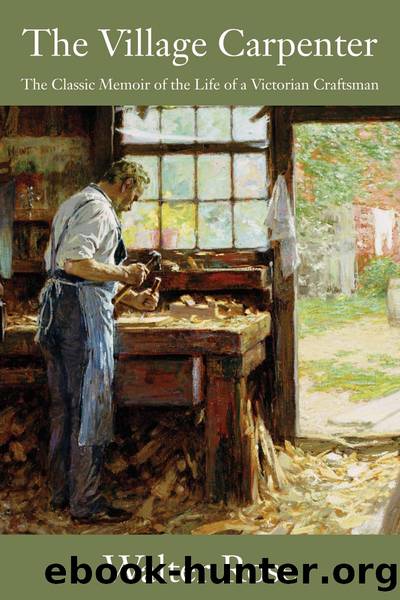The Village Carpenter by Walter Rose

Author:Walter Rose
Language: eng
Format: epub
Publisher: Linden Publishing
Published: 1937-01-15T00:00:00+00:00
Wooden cow-stalls
The ârepairs to gate of pightleâ puzzled me, until I learned that it represented the home enclosure in the days of the open-field system; a little enclosed plot near the homestead for securing cattle at night after they had grazed in the open field all day. These have frequently become the orchards of the modern farms, but are still known occasionally by their original names.
A sound threshing floor was formerly an important necessity of the English farmstead, and this needed periodic attention from the carpenter. It was absolutely essential that there should be no leakage, no open joints between the planks through which the thrashed corn would trickle. Also the planks had to be of tough hard wood to enable them to withstand the thumping of flails, wielded, day after day, by strong men thrashing the kernel from the straw.
The planks were cut from English trees, hornbeam, sycamore, wych-elm and ash being favoured for their compactness and freedom from tendency to shale, which would be a hindrance to the smooth shovelling of the threshed corn. They were usually sawn in their natural curved condition and the curves fitted together with the axe and saw. First, a rough fit was attained with the axe, after which a coarse-set saw was worked again and again between the joints until the fit was perfect.
Every carpenter will understand that in doing so some degree of pressure edgewise was necessary. This was obtained by the use of round irons called âflooring ironsâ shaped like the letter L and used inversely. The joists were bored with vertical holes to take the long arms of the irons and wooden wedges were driven between them and the planks to regulate the pressure. The cramp of the irons enabled them to be withdrawn after use.
The threshing floor was jealously guarded from profane use; the men who cleaned and sacked the threshed corn wore felt slippers in order to avoid crushing the grain.
From the threshing floor the corn was carried to the granary, a building also of prime importance to the farmer, for the care of which the services of the carpenter were frequently required. These buildings were usually constructed of wood; they were raised from the ground on conical stone stattles each surmounted by a round mushroom top, also of stone, the overhanging edge of which prevented the ingress of rats and mice.
The wooden granary, constructed of studs, weather-boarded outside and lined inside with flat smooth boards, was considered drier and thus more fit for the preservation of corn than a building built of bricks or stones. The interiors were fitted with large bins, usually constructed of wide elm boards, in which the corn and ground meals were stored.
The life of the farm involved perpetual warfare against vermin; this mention of rats reminds me of the curious rat traps occasionally made in our workshop for the farmers. They were somewhat cumbersome, but answered well in trapping the rats alive, for which reason they were preferred, in order that young dogs could be trained to kill them.
Download
This site does not store any files on its server. We only index and link to content provided by other sites. Please contact the content providers to delete copyright contents if any and email us, we'll remove relevant links or contents immediately.
The Body: A Guide for Occupants by Bill Bryson(4976)
Audition by Ryu Murakami(4851)
Adulting by Kelly Williams Brown(4488)
Housekeeping by Marilynne Robinson(4349)
Be in a Treehouse by Pete Nelson(3952)
Zero Waste Home by Bea Johnson(3781)
Seriously... I'm Kidding by Ellen DeGeneres(3577)
Better Homes and Gardens New Cookbook by Better Homes & Gardens(3526)
The Healing Self by Deepak Chopra(3476)
Barkskins by Annie Proulx(3313)
Hedgerow by John Wright(3277)
The Cellar by Natasha Preston(3263)
Spark Joy by Marie Kondo(3251)
The Genius of Japanese Carpentry by Azby Brown(3226)
The Life-Changing Magic Of Tidying Up- The Japanese Art Of Decluttering And Organizing (v5.0) by Marie Kondo(3215)
120 Days of Sodom by Marquis de Sade(3184)
Work Clean by Dan Charnas(3051)
The Book of Numbers by Peter Bentley(2912)
A Monk's Guide to a Clean House and Mind by Shoukei Matsumoto(2870)
